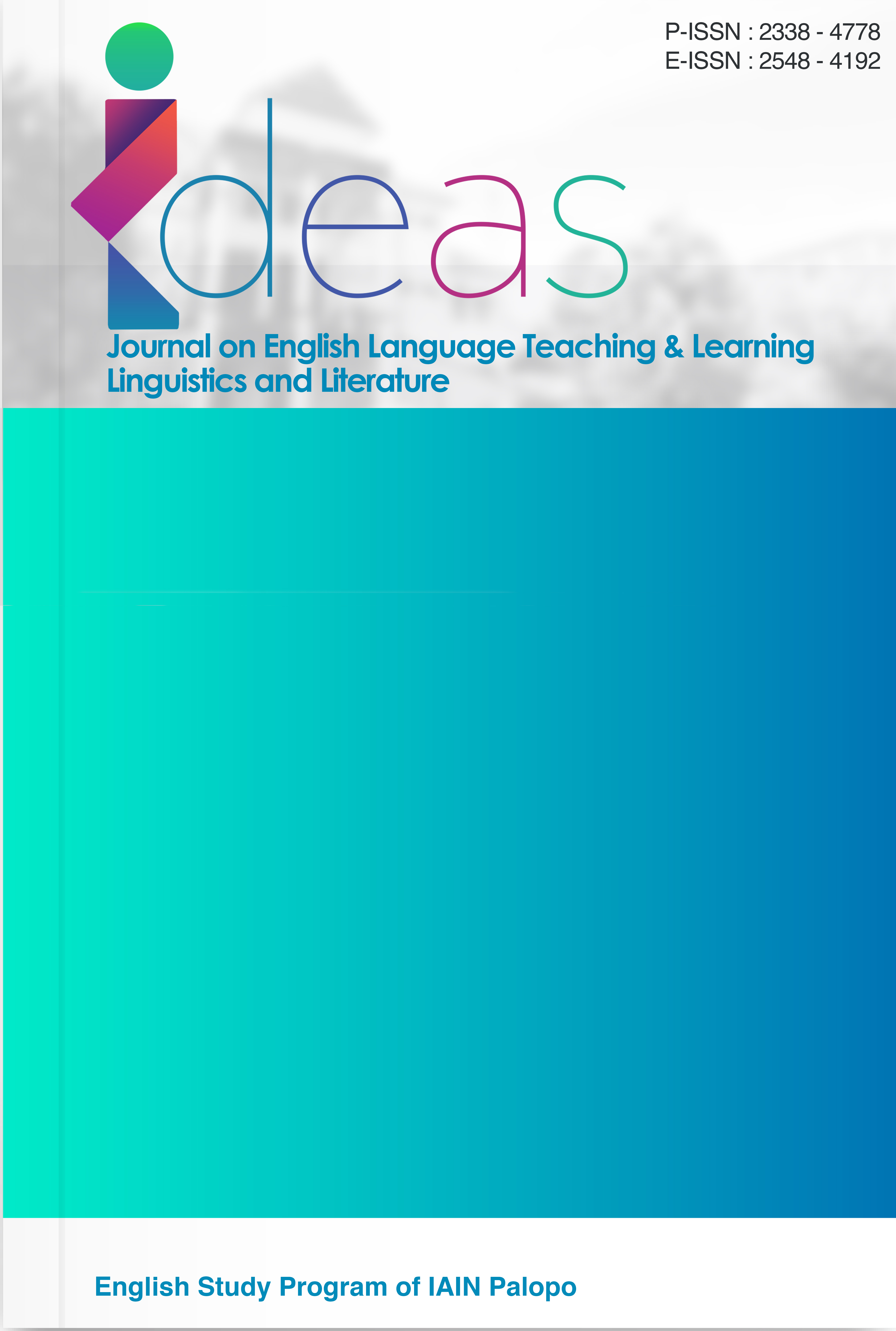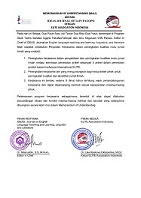Mobile Augmented Reality Storybook Embedded with Local Wisdom: A Needs Analysis of Primary Students in Learning English
DOI:
https://doi.org/10.24256/ideas.v13i2.7964Keywords:
English Language Learning, Storybook, Local Wisdom, Mobile Augmented Reality, Primary School StudentsAbstract
This research investigated the development of a Mobile Augmented Reality (MAR) English storybook embedded with local wisdom to support English learning in primary schools. It focusses to analyse the necessities, lacks, and wants of students and teachers regarding technology-based learning media and to design a preliminary concept of a MAR storybook appropriate for young learners. A qualitative needs analysis was conducted with 50 fourth-grade students and 2 English teachers in primary school in Serang City, Banten Province, Indonesia. Data were collected through questionnaires, interviews, and classroom observations to examine students’ learning habits, teachers’ perspectives, and classroom challenges. The results showed that the majority of students (52% are accustomed to using smartphones, 57% are very familiar with technology, 67% like story-based learning, and 76% are enthusiastic about interactive animation) and teachers need contextual, interactive, and easily accessible learning media, while the shortcomings due to limited infrastructure, teacher training, and the dominance of memorization methods. As a solution, a pre-designed MAR storybook was developed based on Bantenese folktale with simple text, illustrations, audio, AR animation, as well as vocabulary, pronunciation, reflective quizzes, and critical question features in a lightweight, child-friendly application that can be accessed online and offline.
References
Akçayır, M., & Akçayır, G. (2017). Advantages and challenges associated with augmented reality for education: A systematic review of the literature. Educational Research Review, 20, 1–11. https://doi.org/10.1016/j.edurev.2016.11.002
Al-Ali, H., Bazzaza, M. W., Zemerly, M. J., & Ng, J. W. P. (2016). MyVision AIR: An augmented interactive reality book mobile application. 2016 IEEE Global Engineering Education Conference (EDUCON), 741–745. https://doi.org/10.1109/EDUCON.2016.7474634
Anwar, S., Aziz, I., & Susanti, D. (2020). Preserving the Value of Minangkabau Culture Through Local Wisdom-Based Education. Proceedings of the 4th Padang International Conference on Education, Economics, Business and Accounting (PICEEBA-2 2019). https://doi.org/10.2991/aebmr.k.200305.110
Arsal, T., Setyowati, D. L., & Hardati, P. (2023). The Inheritance of Local Wisdom for Maintaining Peace in Multicultural Society. Journal of Aggression, Conflict and Peace Research, 15(2), 137–151. https://doi.org/10.1108/JACPR-01-2022-0673
Azzahra, Z. (2024). Penerapan Pembelajaran Bahasa Inggris Menggunakan Grammar Translation Method di Tingkat Sekolah Dasar. Karimah Tauhid, 3(5), 5805–5812. https://doi.org/10.30997/karimahtauhid.v3i5.13235
Badan Standar, K. dan A. P. (n.d.). Dimensi, Elemen dan Sub elemen Profil Pelajar Pancasila PPP. In Kementerian Pendidikan, Kebudayaan, Riset, dan Teknologi (009/H/KR/2022). Kementerian Pendidikan, Kebudayaan, Riset, dan Teknologi.
Basal, A., Aytan, T., & Demir, I. (2016). Teaching Vocabulary with Graphic Novels. English Language Teaching, 9(9), 95–109. https://doi.org/10.5539/elt.v9n9p95
Bembenutty, H., Liem, G. A. D., Allen, K.-A., King, R. B., Martin, A. J., Marsh, H. W., Craven, R. G., Kaplan, A., Schunk, D. H., DiBenedetto, M. K., & Datu, J. A. D. (2023). Culture, Motivation, Self-Regulation, and the Impactful Work of Dennis M. McInerney. Educational Psychology Review, 35(1), 28. https://doi.org/10.1007/s10648-023-09743-3
Cahya, N., & Syafrizal, S. (2022). The Integrating Local Wisdom In English Learning To Improve Pancasila’s Student Profile. MENDIDIK: Jurnal Kajian Pendidikan Dan Pengajaran, 8(2), 216–221. https://doi.org/10.30653/003.202282.228
Candarli, D. (2023). YouTube for Incidental Vocabulary Learning (pp. 221–240). https://doi.org/10.1007/978-981-99-1490-6_8
Chen, C.-H., Chou, Y.-Y., & Huang, C.-Y. (2016). An Augmented-Reality-Based Concept Map to Support Mobile Learning for Science. The Asia-Pacific Education Researcher, 25(4), 567–578. https://doi.org/10.1007/s40299-016-0284-3
Chen, D., Tsai, S., Hsu, C.-H., Singh, J. P., & Girod, B. (2011). Mobile augmented reality for books on a shelf. 2011 IEEE International Conference on Multimedia and Expo, 1–6. https://doi.org/10.1109/ICME.2011.6012171
Cheng, K.-H., & Tsai, C.-C. (2013). Affordances of Augmented Reality in Science Learning: Suggestions for Future Research. Journal of Science Education and Technology, 22(4), 449–462. https://doi.org/10.1007/s10956-012-9405-9
Demircioglu, T., Karakus, M., & Ucar, S. (2023). Developing Students’ Critical Thinking Skills and Argumentation Abilities Through Augmented Reality–Based Argumentation Activities in Science Classes. Science & Education, 32(4), 1165–1195. https://doi.org/10.1007/s11191-022-00369-5
Enni, E., Nurul Hasanah, & Syahban Mada Ali. (2024). Empowering Reading Comprehension in EFL Vocational School Students through Folktale. JELITA, 5(1), 19–27. https://doi.org/10.56185/jelita.v5i1.596
Faridi, H., Tuli, N., Mantri, A., Singh, G., & Gargrish, S. (2021). A Framework Utilizing Augmented Reality to Improve Critical Thinking Ability and Learning Gain of The students in Physics. Computer Applications in Engineering Education, 29(1), 258–273. https://doi.org/10.1002/cae.22342
Gilmore, K. (2017). Development in the Digital Age. The Psychoanalytic Study of the Child, 70(1), 82–90. https://doi.org/10.1080/00797308.2016.1277895
Han, H., Røkenes, F. M., & Krumsvik, R. J. (2023). Student teachers’ perceptions of flipped classroom in EFL teacher education. Education and Information Technologies, 1–20. https://doi.org/10.1007/s10639-023-11839-w
He, X., & Li, Y. (2023). Effect of learning methods and cognitive characteristics on preschoolers’ online English attainment. Education and Information Technologies, 1–19. https://doi.org/10.1007/s10639-022-11551-1
Hsu, T.-C. (2017a). Learning English with Augmented Reality: Do Learning Styles Matter? Computers & Education, 106, 137–149. https://doi.org/10.1016/j.compedu.2016.12.007
Hsu, T.-C. (2017b). Learning English with Augmented Reality: Do Learning Styles Matter? Computers & Education, 106, 137–149. https://doi.org/10.1016/j.compedu.2016.12.007
Ibáñez, M.-B., & Delgado-Kloos, C. (2018). Augmented Reality for STEM Learning: A Systematic Review. Computers & Education, 123, 109–123. https://doi.org/10.1016/j.compedu.2018.05.002
Jing, M., Ye, T., Kirkorian, H. L., & Mares, M. (2023). Screen media exposure and young children’s vocabulary learning and development: A meta‐analysis. Child Development. https://doi.org/10.1111/cdev.13927
Jitpranee, J., Songsirisak, P., Cheewinwilaiporn, D., & Kantamas, K. (2024). Enhancing Ethnic Secondary Students’ English and Cultural Knowledge through Folktales and Storytelling Using Picture Series. REFLections, 31(2). https://doi.org/10.61508/refl.v31i2.274976
Kasman, K., & Lubis, S. K. (2022). Teachers’ Performance Evaluation Instrument Designs in the Implementation of the New Learning Paradigm of the Merdeka Curriculum. Jurnal Kependidikan: Jurnal Hasil Penelitian Dan Kajian Kepustakaan Di Bidang Pendidikan, Pengajaran Dan Pembelajaran, 8(3), 760. https://doi.org/10.33394/jk.v8i3.5674
Khasinah, S., & Elviana, E. (2022). Need Analysis dalam Pengembangan Kurikulum. Jurnal MUDARRISUNA: Media Kajian Pendidikan Agama Islam, 12(4), 837. https://doi.org/10.22373/jm.v12i4.17208
Khoa, B. T., Hung, B. P., & Hejsalem-Brahmi, M. (2023). Qualitative research in social sciences: data collection, data analysis and report writing. International Journal of Public Sector Performance Management, 12(1–2), 187–209.
Kustyarini, K., Utami, S., & Koesmijati, E. (2020). The Importance of Interactive Learning Media in A New Civilization Era. European Journal of Open Education and E-Learning Studies, 5(2). https://doi.org/10.46827/ejoe.v5i2.3298
Lemon, L. L., & Hayes, J. (2020). Enhancing Trustworthiness of Qualitative Findings: Using Leximancer for Qualitative Data Analysis Triangulation. The Qualitative Report, 5(3), 604–614. https://nsuworks.nova.edu/tqr/vol25/iss3/3/
Liao, C.-H. D., Wu, W.-C. V., Gunawan, V., & Chang, T.-C. (2023). Using an Augmented-Reality Game-Based Application to Enhance Language Learning and Motivation of Elementary School EFL Students: A Comparative Study in Rural and Urban Areas. The Asia-Pacific Education Researcher, 1–13. https://doi.org/10.1007/s40299-023-00729-x
Meyers, E. M., Erickson, I., & Small, R. V. (2013). Digital Literacy and Informal Learning Environments: An Introduction. Learning, Media and Technology, 38(4), 355–367. https://doi.org/10.1080/17439884.2013.783597
Mustafa, A. (2020). The Folktales of Palestine: Cultural Identity, Memory and the Politics of Storytelling, by Farah Aboubakr. Middle East Journal of Culture and Communication, 13(3), 327–331. https://doi.org/10.1163/18739865-01303004
Nisa, H., Mega Febriani Sya, Rachmah Amalia, & Alia Febriani. (2024). Pendekatan Pembelajaran Bahasa Inggris di Sekolah Dasar: The Grammar Traslation Method dan The Direct Method. Karimah Tauhid, 3(5), 5397–5409. https://doi.org/10.30997/karimahtauhid.v3i4.13213
Nuñez Enriquez, O., & Oliver, K. L. (2021). ‘The Collision of Two worlds’: When a Teacher-Centered Facilitator Meets a Student-Centered Pedagogy. Sport, Education and Society, 26(5), 459–470. https://doi.org/10.1080/13573322.2020.1738374
Oktavia, D., Habibah, N., Balti, L., & Kurniawan, R. (2023). Kurikulum Merdeka dan Pengajaran Bahasa Inggris di Sekolah Dasar: Need Ansalisis Study. Jurnal Muara Pendidikan, 8(1), 257–265. https://doi.org/10.52060/mp.v8i1.1260
Oranç, C., & Küntay, A. C. (2019). Learning from The Real and The Virtual Worlds: Educational Use of Augmented Reality in Early Childhood. International Journal of Child-Computer Interaction, 21, 104–111. https://doi.org/10.1016/j.ijcci.2019.06.002
Pantaleo, S. (2023). Kindergarten Children’s Talk About Illustration Techniques in an Almost Wordless Picturebook. Early Childhood Education Journal, 1–15. https://doi.org/10.1007/s10643-023-01458-y
Pratama, S. S., & Hadi, M. S. (2023). The Vocabulary Building Audio-Visual Media: An Innovation in Vocabulary Expertise. Jurnal Studi Guru Dan Pembelajaran, 6(1), 1–8. https://doi.org/10.30605/jsgp.6.1.2023.1994
Puspita, D. R., & Rosnaningsih, A. (2019). Need Analysis of Speaking Skill by Using Simulation for Students of Primary School Teacher Education. Journal of English Language Studies, 4(2), 159. https://doi.org/10.30870/jels.v4i2.6197
Puspita, D. R., & Rosnaningsih, A. (2023). Analisis Kebutuhan Mahasiswa dalam Mengembangkan Bahan Ajar English for Children. Edukasi: Jurnal Pendidikan, 21(1), 27–40. https://doi.org/10.31571/edukasi.v21i1.5474
Quraish, Q., Kridalukmana, R., & Martono, K. T. (2016). Buku Pembelajaran Bahasa Inggris dengan Teknologi Augmented Reality Berbasis Android. Jurnal Teknologi Dan Sistem Komputer, 4(1), 102. https://doi.org/10.14710/jtsiskom.4.1.2016.102-108
Richards, J. C. (2015). Key Issues in Language Teaching. Cambridge University Press.
Roumba, E., & Nicolaidou, I. (2022). Augmented Reality Books: Motivation, Attitudes, and Behaviors of Young Readers. International Journal of Interactive Mobile Technologies (IJIM), 16(16), 59–73. https://doi.org/10.3991/ijim.v16i16.31741
Sibarani. (2012). Kearifan Lokal: Hakikat, Peran, dan Metode Tradisi Lisan (1st ed.). Asosiasi Tradisi Lisan.
Şimşek, B., & Direkçi, B. (2023). The Effects of Augmented Reality Storybooks on Student’s Reading Comprehension. British Journal of Educational Technology, 54(3), 754–772. https://doi.org/10.1111/bjet.13293
Singh, B. (2019). Character education in the 21st century. Journal of Social Studies (JSS), 15(1), 1–12. https://doi.org/10.21831/jss.v15i1.25226
Singh, R., Awasthi, S., & Singh, M. R. (2020). Updated Comparative Analysis on Video conferencing Platforms - Zoom, Google meet, Microsoft Teams, WebEx Teams and GoToMeetings.
Sintadewi, N. M. D., Artini, N. P. J., & Febryan, I. (2020). Analysis of English Learning Difficulty of Students in Elementary School. International Journal of Elementary Education, 4(3), 431. https://doi.org/10.23887/ijee.v4i3.28524
Songsirisak, P., Jitpranee, J., Saejao, Y., & Singsutin, N. (2024). Ethnic Folktale-Based Materials Development for Secondary Students’ Learning. Humanities, Arts and Social Sciences Studies. https://doi.org/10.69598/hasss.24.1.263505
Sugiyono. (2011). Metode Penelitian Kuantitatif Kualitatif dan R&D. Alfabeta.
Sukma, N., Stkip, P., & Yuwana, W. (2022). Game Based Learning Sebagai Salah Satu Solusi dan Inovasi Pembelajaran Bagi Generasi Digital Native. Jurnal Pendidikan Agama Katolik (JPAK), 22(2), 2085–0743. https://doi.org/10.34150/jpak.v22i1.433
Suryanto, & Sari, Z. E. (2021). Difficulties and Strategies in Learning English: An Analysis of Students From English and Non-English Education Department in Indonesia. Proceedings of the 4th International Conference on Sustainable Innovation 2020–Social, Humanity, and Education (ICoSIHESS 2020). https://doi.org/10.2991/assehr.k.210120.140
Sya, M. F., & Helmanto, F. (2020). Pemerataan Pembelajaran Muatan Lokal Bahasa Inggris Sekolah Dasar Indonesia. DIDAKTIKA TAUHIDI: Jurnal Pendidikan Guru Sekolah Dasar, 7(1), 71. https://doi.org/10.30997/dt.v7i1.2348
Syahfitri, J. (2024). The Utilization of Local Wisdom-based Interactive Digital Module to Improve Students’ Critical Thinking Skills. International Journal of STEM Education for Sustainability, 4(1), 110–119. https://doi.org/10.53889/ijses.v4i1.305
Vate-U-Lan, P. (2012). An Augmented Reality 3D Pop-Up Book: The Development of a Multimedia Project for English Language Teaching. 2012 IEEE International Conference on Multimedia and Expo, 890–895. https://doi.org/10.1109/ICME.2012.79
Yakumbu, S., Resdi, & Darni, D. (2025). Integrating Folktales Teaching in Improving Students’ Writing Skills. Journal of Education and Teacher Training Innovation, 2(2), 153–163. https://doi.org/10.61227/jetti.v2i2.137
Yuzianah, D., Budi Darmono, P., Supriyono, S., & Kurniawan, H. (2023). Penerapan P5 Pada Kurikulum Merdeka Pada Jenjang SD. Taroa: Jurnal Pengabdian Masyarakat, 2(2), 10–17. https://doi.org/10.52266/taroa.v2i2.1069
Downloads
Published
Issue
Section
Citation Check
License
Copyright (c) 2025 Asih Rosnaningsih, Asep Muhyidin, Sholeh Hidayat, Yudi Juniardi

This work is licensed under a Creative Commons Attribution-ShareAlike 4.0 International License.
Authors retain copyright and grant the journal right of first publication with the work simultaneously licensed under an Attribution-ShareAlike 4.0 International (CC BY-SA 4.0) that allows others to share the work with an acknowledgement of the work's authorship and initial publication in this journal.
Authors are able to enter into separate, additional contractual arrangements for the non-exclusive distribution of the journal's published version of the work (e.g., post it to an institutional repository or publish it in a book), with an acknowledgement of its initial publication in this journal.
Authors are permitted and encouraged to post their work online (e.g., in institutional repositories or on their website) prior to and during the submission process, as it can lead to productive exchanges, as well as earlier and greater citation of published work (See the Effect of Open Access)




